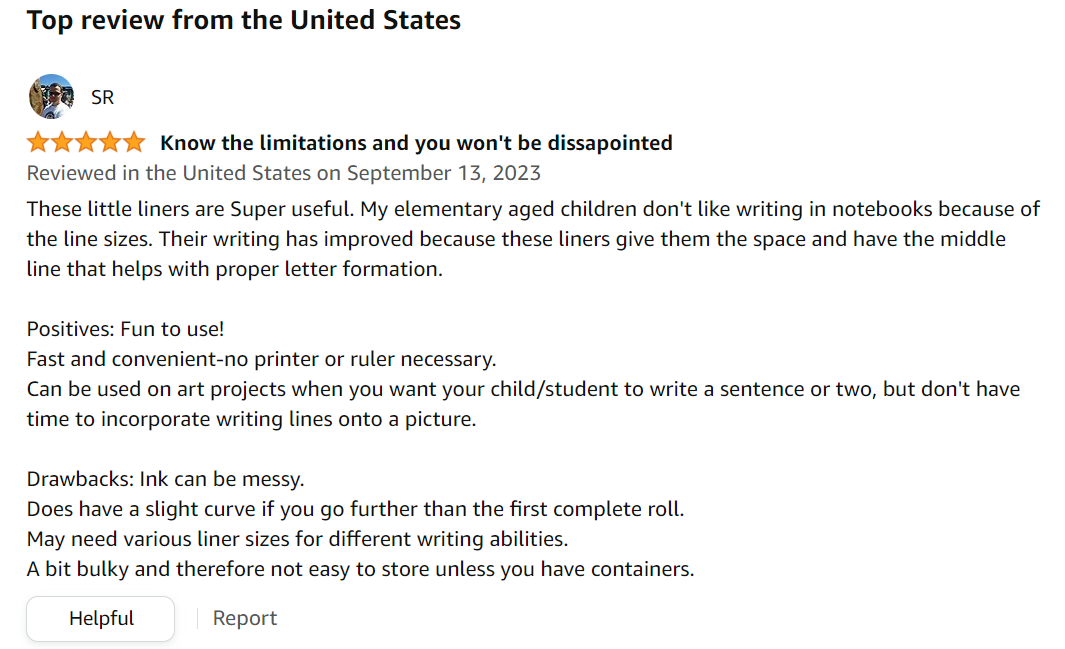Our Story - Blog result Legi Liner
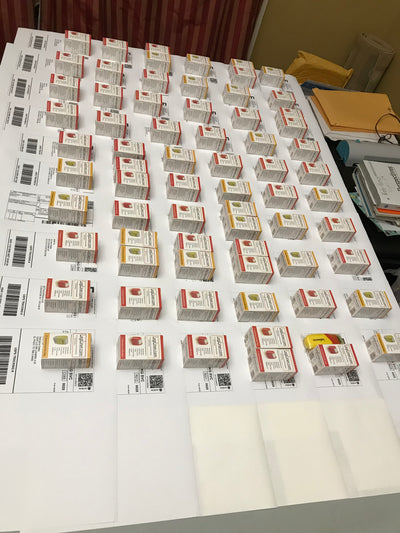
We went viral!
Blog posts
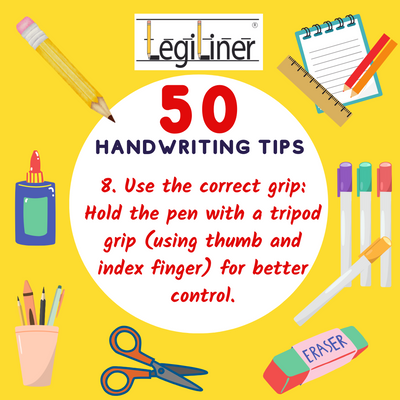
Tip #8: "Use the correct grip for Handwriting."
Today, we unveil Tip #8: "Use the correct grip: Hold the pen or pencil with a tripod grip (using thumb and index finger) for better control.
An efficient grip will allow students to write longer without fatigue. Both Tripod and Quadrupod grasps are considered functional and efficient. The tripod grasp has 3 points of contact on the pen or pencil and the quadrupod grasp has 4 points of finger contact on the marker or crayon.
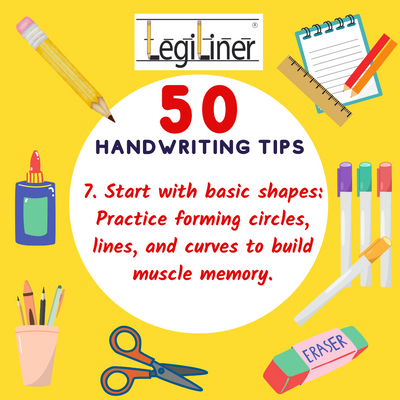
Handwriting tip 7 of 50: Start with basic shapes!
Handwriting tip 7 of 50: Start with basic shapes! Practice forming circles, lines, and curves to build muscle memory.
Welcome back to our Handwriting Tips Series, where we're on a mission to elevate your penmanship to new heights. Today, we unveil Tip #7: "Start with Basic Shapes!" Often overlooked, practicing fundamental shapes like circles, lines, and curves lays a solid foundation for developing handwriting legibility. Let's explore how incorporating these elementary elements into your practice routine can enhance your child's muscle memory and overall writing proficiency.
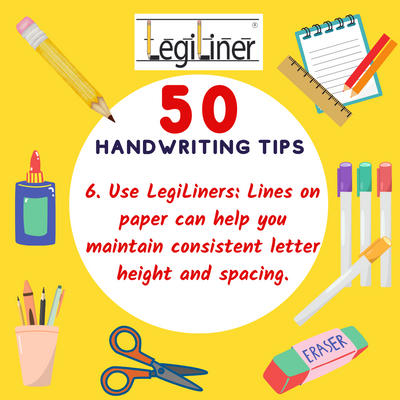
Handwriting Tip 6 of 50: 6. Use LegiLiners!
Handwriting Tip 6 of 50: 6. Use LegiLiners: Lines on paper can help you maintain consistent letter height and spacing.
In our ongoing Handwriting Tips Series, we're excited to introduce Tip #6: "Use LegiLiners!" Imagine having the power to quickly draw perfect lines on any paper. With LegiLiners, this becomes a reality! Lines on paper are not just for fun; they play a crucial role in helping you practice consistent letter height and spacing. Let's explore how LegiLiners, rolling ink stamps designed for this purpose, can revolutionize your handwriting experience.
The LegiLiners Advantage:
-
Swift Precision: LegiLiners eliminate the need for manual line-drawing, saving you time and effort. These rolling ink stamps effortlessly create straight, consistent lines on your paper, providing a quick and efficient solution for maintaining uniform letter height.
-
Effortless Consistency: With LegiLiners, achieving consistency in letter sizing and spacing in your handwriting becomes practically effortless. Each stamp is color coded to size and helps to reduce letter sizing as skill level progress.
-
Adaptable and Creative: LegiLiners aren't limited to traditional paper. You can use them to practice on construction paper, paper plates, crafts and a variety of materials. Explore creative possibilities while still benefiting from the consistency that LegiLiners offer.
Practical Tips for Implementation:
-
Select the Right LegiLiner: Choose a LegiLiner with the line spacing that suits your handwriting style. Whether you prefer tall or short, narrow or wide spacing, LegiLiners come in various options to cater to your specific needs. Take our quiz to see what LegiLiner is right for you! QUIZ
-
Explore Different Patterns: LegiLiners aren't confined to straight lines. Some models offer dotted or dashed patterns, squares or shading to help you cater to your specific child's needs.
-
Ideal for Practice Sessions: Make LegiLiners a part of your regular practice routine. Their efficiency makes them a valuable tool for honing your handwriting skills, allowing you to focus on other aspects of your technique.
Conclusion:
Tip #6 invites you to embrace the convenience and consistency of LegiLiners in your pursuit of more legible handwriting. These rolling ink stamps are amazing tools; and imperative for transforming your writing experience. Say goodbye to the hassle of drawing lines manually and welcome the efficiency and creativity that LegiLiners bring to your handwritten expression. Stay tuned for more tips as we continue our Handwriting Tips Series!
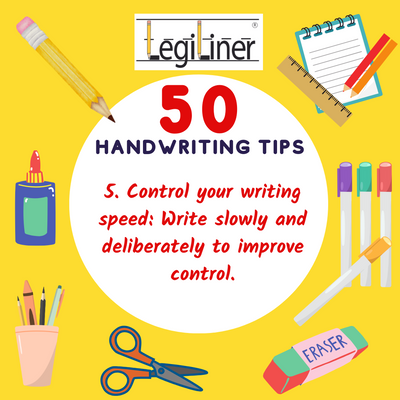
Handwriting Tip 5 of 50: Control your writing speed:
5. Control your writing speed: Write slowly and deliberately to improve legibility.
Welcome back to our Handwriting Tips! In our ongoing journey to enhance your legibility, we bring you Tip #5: "Control Your Writing Speed." Today, we discuss the significance of writing slowly and deliberately as a means for your student to improve control over handwriting output. Let's explore how this simple adjustment can make a profound impact on the quality of your handwriting.
The Need for Speed - Stop and Control:
Here's why it matters:
-
Precision over Haste: Writing slowly allows you to focus on each letter, ensuring correct formation sequence when writing letters and words.
-
Consistency in Size and Style: Writing fast often leads to mixing of sizes of letters. By slowing down, the student gains the ability to maintain consistency, creating a more uniform look on paper.
-
Reduced Mistakes: Rushed writing is prone to errors such as illegible characters, misspelled words, and skipped letters. Writing at a controlled pace minimizes these mistakes, resulting in a more error-free final product.
Practical Tips for Implementation:
-
Conscious Awareness: Check your student's current writing speed by timing one sentence. Have them slow down to write neater and time them on the same sentence. Help them see which letters or words are neater when they take their time.
-
Practice Regularly: Like any skill, mastering the art of controlled writing speed requires practice. Set aside dedicated time to build muscle memory and consistency. Consider using a tracing app to ingrain the motor memory.
-
Use Guidelines: Consider using lined paper or LegiLiner guidelines to help regulate the size and spacing of your letters. This simple tool can act as a visual cue, slowing the student to maintain control over their writing speed.
Conclusion:
In the pursuit of more legible handwriting, Tip #5 encourages you to embrace the power of controlled writing speed. By slowing down and forming letters carefully, the student will take more control over their writing output. Remember, each stroke matters, and with practice, they'll find that the self-confidence of handwriting lies not just in the words they write, but in the deliberate care they invest in every letter. Stay tuned for more tips to refine your penmanship in our ongoing series!


